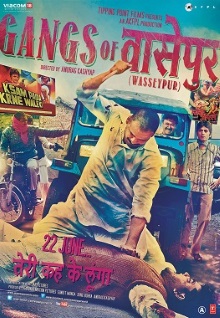
Once again I heard about this epic from The Economist which annoys my wife to no end as Indian films tend to be tediously long. This one more than qualifies for being long as the whole thing comes to well over five hours. It was divided into two parts for theatrical release and so this post covers the first part.
The tale begins in the 1940s when a Pathan Shahid Khan impersonates a famous Qureshi bandit Sultana Dacoit to rob British trains. After being exposed, he takes up employment in the coal mines of Dhanbad and due to his viciousness rises to become an enforcer under local strongman Ramadhir Singh who gains control of the mines after India’s independence. When the boss hears about Shahid’s ambition to overthrow him however, he sends Qureshi killers after his family and lures Shahid himself into a trap. Shahid is killed but his servant leads his family in time to safety and raises his son Shadar Khan. Twenty years later as an adult Shadar swears vengeance against Ramadhir who has since gotten himself elected as minister of the state. Thus begins the epic feud between the three families: the Khans, Ramadhir Singh and his son J.P., and the Qureshis that would span decades to determine control of Wasseypur which as I understand it is now a part of the greater city of Dhanbad.
By dint of taking place over such an extended period of time and involving so many characters, there is so much material to cover that the film is mostly able to avoid the time wasting dragginess that is so common in Indian cinema. That said with so many storylines and characters to keep track of, it is possible to get confused if you’re not good at remembering Indian names. I thought that they did a fairly good job at making sure everything is clear by constantly referring to people’s names though you do need to be a bit patient as the full consequences of a scene might only be made known later. I also liked that there are no song and dance routines performed by the characters in the film which would detract from its grittiness. There is music, either in the background or performed by other on-screen musicians and that’s fine. The lyrics are always topical and frankly shocked me by how lurid and crude they are which perfectly matches the film’s tone.
Production values are excellent all around with the violence being both brutal and realistic. The crude, low-tech weapons they employ and the seemingly ad hoc attacks accentuate the savagery. For the most part these aren’t slick, professional killers, just gangsters who are ruthless. It’s actually a little confusing how the power dynamics work as each party is well aware of where their enemies live yet leave them alone most of the time. I think this is because they mainly rule through fear and it takes a special kind of courage or maybe recklessness to escalate and upset the balance of power. There’s great stuff here about the local culture as well such as their marriage ceremonies and Ramadhir’s reluctance to directly employ violence, reasoning that being a Hindu himself, he needs to use Muslims, in this case the Qureshis, to fight another Muslim, the Khan family. The film doesn’t mention this but I wonder if it might be because as the minister he is careful about sparking a wider Hindu versus Muslim conflict. Also interesting is how Nasir who was a servant of Shahid Khan subsequently raised his son but is still seen as servant by the family while his own son becomes Shadar’s chief lieutenant.
One weakness is that the film sort of glosses over the economics. The Khan family must have earned a ridiculous fortune over the decades yet they aren’t visibly very rich. It’s remarkable to me that Ramadhir and his son look so much richer and nominally control the police yet seem to be fearful of the Khans. Another problem is that while the story involves the three factions, the Khans are the protagonists and so we mostly see things from their point of view. This makes it a little hard to understand why the police are so weak in Wasseypur or how Shadar can break out of prison and after hiding out for a while return to his normal life without fear of being rearrested.
All this is of course inspired by real events though names have been changed and no doubt plenty of details have been fictionalized. To me, this adds a stranger than fiction aspect to the tale and I like that storylines aren’t always neatly bookended and characters come and go which adds uncertainty and surprise. As a work of art, it’s not that great being too haphazard and lacking any kind of thematic coherence beyond letting you know what a lawless shithole the place is. As a fictionalized documentary however it’s incredibly absorbing. This is probably as close as you can get to an Indian Godfather film.
One thought on “Gangs of Wasseypur – Part 1 (2012)”